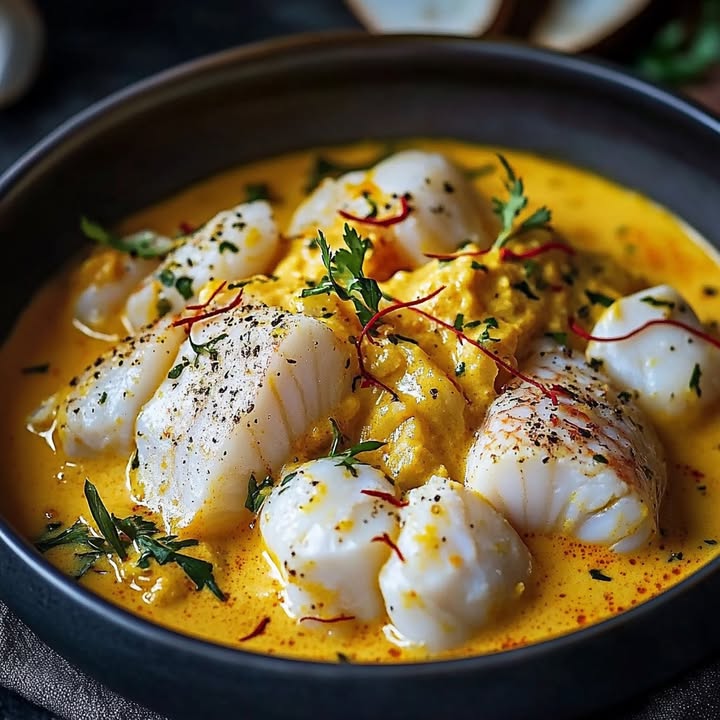
Why This Coconut Curry Fish Will Make You Smile
Let me tell you about the first time I made this Coconut Curry Fish. It was a rainy Sunday afternoon, and I wanted something comforting yet exotic. I had some fresh fish in the fridge, a can of coconut milk, and a jar of curry powder. Little did I know, this dish would become my go-to recipe for impressing friends and family. The creamy sauce, the tender fish, and that hint of tropical flair? Pure magic. Whether you’re new to cooking fish or a seasoned pro, this recipe is foolproof and full of flavor.
A Little History Behind Coconut Curry Fish
This dish draws inspiration from both French blanquette recipes and Southeast Asian flavors. A traditional blanquette is a creamy stew, often made with chicken or veal, but here we’re swapping in fish and shrimp for a lighter twist. The addition of coconut milk and curry powder gives it a modern, tropical vibe. I love how this Coconut Curry Fish bridges cultures—French elegance meets bold, spicy aromas. When I tested this recipe, I added a squeeze of lime and fresh dill at the end. Trust me, it’s the little touches that make all the difference.
Why You’ll Love This Recipe
First off, it’s simple. No fancy techniques or hard-to-find ingredients here. Just fresh fish, spices, and a few pantry staples. The combination of creamy coconut milk, zesty lime, and warm curry creates a symphony of flavors. Plus, it’s quick! Perfect for busy weeknights or when you want to wow guests without spending hours in the kitchen. And let’s not forget—it’s healthy. Packed with protein and omega-3s, this Coconut Curry Fish is as good for your body as it is for your taste buds.
Perfect Occasions to Prepare This Recipe
Whether you’re hosting a dinner party, celebrating a special occasion, or just craving something cozy yet exciting, this dish fits the bill. I’ve served it on birthdays, anniversaries, and even casual Friday nights. Pair it with steamed rice or crusty bread, and you’ve got a meal that feels like a vacation in a bowl. It’s also a great way to introduce seafood skeptics to the joys of fish!
Ingredients
- 400 g of firm white fish (cod, haddock, or monkfish), cut into large cubes
- 300 g of raw, peeled shrimp
- 3 teaspoons of powdered fish stock
- 1 teaspoon of coconut oil
- 1 finely chopped shallot
- 100 ml of dry white wine (like Sauvignon Blanc or Pinot Grigio)
- 15 g of cornstarch
- 1 tablespoon of thick cream (at least 30% fat)
- 100 ml of light or full-fat coconut milk
- 2 teaspoons of curry powder
- Fresh dill, chopped for garnish
- Fine sea salt and freshly ground black pepper
- 1 small piece of fresh ginger (about 2 cm), peeled and finely grated
- Juice and zest of one lime
- Optional: a pinch of chili for heat
Substitution Options
- Fish: Swap white fish for salmon or trout if you prefer richer flavors.
- Shrimp: Use scallops or crab meat instead for a luxurious twist.
- Coconut Milk: If unavailable, heavy cream works as a substitute, though it won’t have the same tropical flair.
- Wine: Replace with vegetable broth if you prefer a non-alcoholic option.
- Dill: Cilantro or parsley can stand in if dill isn’t your thing.
Preparation Section
Step 1: Prepare the Fish Broth
Start by bringing 300 ml of water to a boil in a medium pot. Add 3 teaspoons of powdered fish stock and stir until dissolved. Lower the heat to a gentle simmer. Carefully add the fish cubes and shrimp, letting them poach for 3-4 minutes until opaque and pink. Use a slotted spoon to remove them and set aside. Pro tip: Don’t overcook the seafood at this stage—it will finish cooking later in the sauce.
Step 2: Build the Flavor Base
In a large skillet over medium heat, melt 1 teaspoon of coconut oil. Add the chopped shallot and grated ginger, sautéing for 2-3 minutes until fragrant and soft. Deglaze the pan with 100 ml of white wine, scraping up any browned bits. Let the wine reduce by half, about 2-3 minutes. This step builds depth, so take your time. Chef’s tip: Toast the curry powder briefly in the pan before adding liquids for an extra layer of flavor.
Step 3: Create the Creamy Sauce
Remove the skillet from heat and whisk in 100 ml of coconut milk, 15 g of cornstarch, and 2 teaspoons of curry powder. Stir vigorously to avoid lumps. Gradually pour in 200-250 ml of hot fish broth while continuing to whisk. Return the skillet to low heat and stir in 1 tablespoon of thick cream. Season with salt, pepper, lime juice, and zest. The sauce should thicken slightly, coating the back of a spoon beautifully.
Step 4: Combine and Finish
Gently fold the reserved fish and shrimp into the sauce. Simmer for 2-3 minutes, ensuring everything heats through without boiling. Taste and adjust seasoning, then sprinkle with fresh dill. Serve hot with steamed rice or crusty bread. The vibrant green dill against the creamy yellow sauce is a feast for the eyes!
Timing
- Prep Time: 15 minutes
- Cooking Time: 20 minutes
- Total Time: 35 minutes
Chef’s Secret
To elevate this dish, use freshly grated ginger and lime zest. The oils released during grating add a burst of freshness that dried spices simply can’t match. Also, don’t skip the final squeeze of lime—it brightens the entire dish.
Extra Info
Did you know that coconut milk has been used in tropical cuisines for centuries? Its natural sweetness balances spicy curries perfectly. Fun fact: In Southeast Asia, coconut milk is often called “the milk of paradise.” After tasting this Coconut Curry Fish, you’ll understand why!
Necessary Equipment
- Medium-sized pot
- Large skillet or frying pan
- Whisk
- Slotted spoon
- Grater or zester
Storage
If you have leftovers, store them in an airtight container in the fridge for up to 2 days. Reheat gently on the stovetop, adding a splash of water or coconut milk to loosen the sauce. Avoid freezing this dish, as the texture of the fish and shrimp may change upon thawing.
For longer storage, consider freezing just the sauce without the seafood. When ready to eat, defrost and reheat, then add freshly cooked fish and shrimp for optimal texture.
Always label your containers with the date to keep track of freshness. Proper storage ensures you enjoy every bite as if it were freshly made.
Tips and Advice
- Use the freshest fish and shrimp available for the best results.
- Adjust the curry powder to suit your spice tolerance.
- Don’t rush the reduction of the wine—it concentrates the flavors.
- Keep the heat low when combining the fish with the sauce to prevent breaking.
Presentation Tips
- Serve in shallow bowls with a sprinkle of dill for color.
- Add a wedge of lime on the side for a pop of brightness.
- Garnish with toasted coconut flakes for a crunchy contrast.
Healthier Alternative Recipes
Here are six variations to make this Coconut Curry Fish even healthier:
- Lighter Sauce: Use low-fat coconut milk and Greek yogurt instead of cream.
- Vegan Option: Replace fish and shrimp with tofu or chickpeas.
- Gluten-Free: Ensure your fish stock and curry powder are gluten-free.
- Low-Sodium: Opt for unsalted fish stock and limit added salt.
- Keto-Friendly: Skip the cornstarch and thicken the sauce with xanthan gum.
- Spice Lover’s Delight: Add extra chili or red pepper flakes for heat.
Common Mistakes to Avoid
Mistake 1: Overcooking the Seafood
Overcooked fish and shrimp turn rubbery, ruining the dish’s delicate texture. To avoid this, poach them gently in the broth and finish cooking in the sauce. Pro tip: Remove the seafood from heat just before it’s fully done—it will continue cooking in residual heat.
Mistake 2: Skipping the Wine Reduction
Rushing the wine reduction step dilutes the sauce’s flavor. Let the alcohol evaporate completely, leaving behind a rich, concentrated base. Patience pays off here!
Mistake 3: Not Whisking Enough
Failing to whisk thoroughly when adding cornstarch can lead to lumpy sauce. Take your time and whisk continuously until smooth. A smooth sauce equals happy diners.
FAQ
What type of fish works best?
Firm white fish like cod, haddock, or monkfish hold their shape well during cooking. Avoid delicate varieties like tilapia, which may fall apart.
Can I make this ahead?
While best served fresh, you can prep components like the broth and sauce ahead. Combine everything just before serving for optimal texture.
Is this dish spicy?
The level of spiciness depends on the curry powder and optional chili. Adjust to your preference, starting with mild curry and adding heat gradually.
What sides pair well?
Steamed jasmine rice, quinoa, or crusty baguette slices complement the creamy sauce beautifully. A side salad adds freshness.
Can I use frozen shrimp?
Yes, but thaw them completely and pat dry before cooking to prevent excess moisture from watering down the sauce.
How do I store leftovers?
Store in an airtight container in the fridge for up to 2 days. Reheat gently on the stovetop, adding liquid as needed.
What if I don’t have white wine?
No problem! Substitute with vegetable broth or a splash of apple cider vinegar for acidity.
Why does my sauce taste bland?
You might need more seasoning. Add a pinch of salt, a squeeze of lime, or a dash of curry powder to boost flavor.
Can I freeze this dish?
Freezing isn’t ideal due to the texture changes in seafood. However, you can freeze the sauce alone and add fresh fish later.
What’s the key to a silky sauce?
Whisk constantly when adding cornstarch, and cook over low heat to prevent clumping. Strain the sauce if necessary for extra smoothness.
Final Thoughts
This Coconut Curry Fish is a celebration of flavors, textures, and simplicity. Whether you’re cooking for yourself or sharing it with loved ones, it’s a dish that brings joy to the table. So grab your apron, gather your ingredients, and let’s create something delicious together. Bon appétit!

Coconut Curry Fish
Ingredients
Equipment
Method
- Bring 300 ml of water to a boil in a medium pot, add powdered fish stock and stir until dissolved.
- Add fish cubes and shrimp to the pot and poach for 3-4 minutes until opaque and pink; set aside.
- In a large skillet, melt coconut oil over medium heat, add chopped shallot and grated ginger, sauté for 2-3 minutes.
- Deglaze the skillet with white wine, scraping up browned bits, and let wine reduce by half.
- Remove skillet from heat and whisk in coconut milk, cornstarch, and curry powder, stirring to avoid lumps.
- Gradually pour in hot fish broth while whisking, return to low heat, and stir in thick cream.
- Season with salt, pepper, lime juice, and zest; allow sauce to thicken slightly.
- Fold in reserved fish and shrimp, simmer for 2-3 minutes until heated through, then sprinkle with fresh dill.
- Serve hot with steamed rice or crusty bread.
